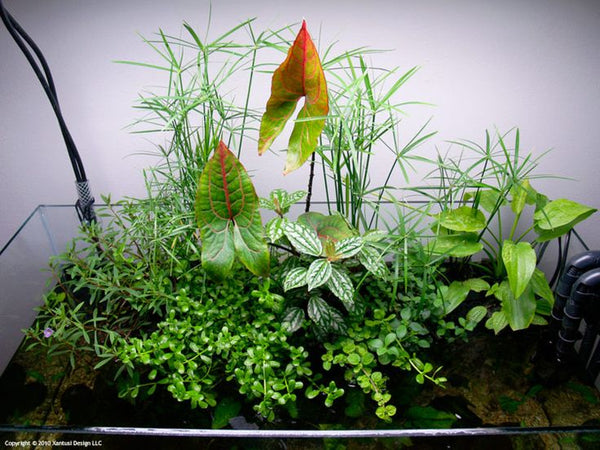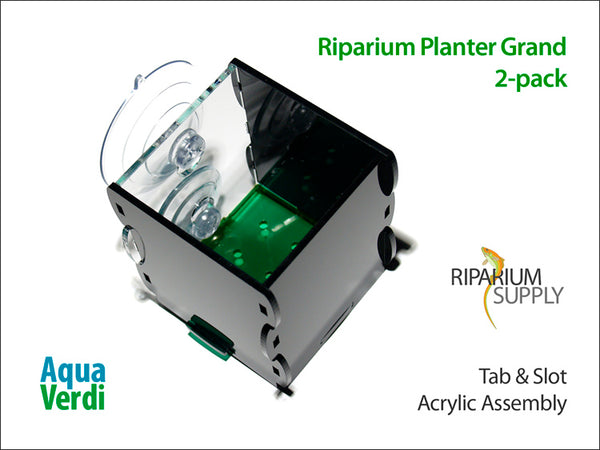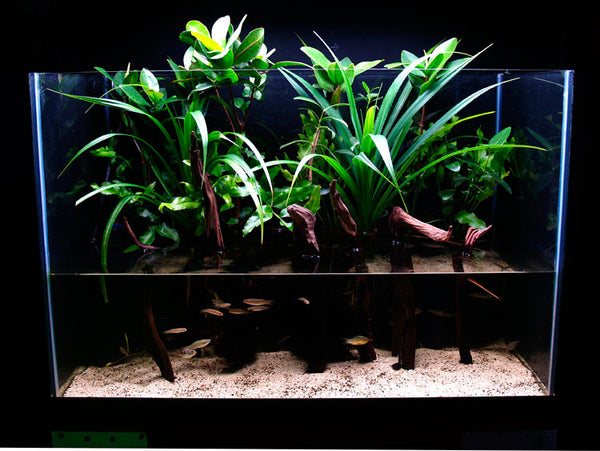News / mangrove
New Riparium Plants - 23 March
We have received a new plant order from one of our suppliers and it includes some really excellent material, including selections that we have not listed in a while and others that are new for our online store.
We have received quite a few inquiries about Acrostichum Leather Fern (1) and we are pleased to have them in stock again. This is a striking swamp fern for larger plantings and can even growing in mildly brackish water. It looks especially good in combination with mangrove trees. It will grow very well in the Riparium Supply, Riparium Planter Grand.
A botanically-interesting species, Anemopsis Yerba Mansa (2) has a range restricted to the Western United States where it grows in sunny, marshy areas. It bears unique foliage and blooms.
Spilanthes Toothache Plant (3) blooms with frequent compound flowers resembling thimbles. This marsh plant from South America grows to just a few inches tall and might be a good choices for nano riparium plantings.
Cyperus Dwarf Umbrella Sedge (4) is a versatile and easy-to-grow riparium plant that works especially well as grassy background foliage repeated in several riparium planters.
Saururus Lizard's Tail (5), a plant relative of Anemopsis Yerba Mansa, is a bushy herbaceous native to Eastern North America. It looks good with many other kinds of riparium plants.
Stay tuned! We'll have more updates on the way for these new plants and more!

New Riparium Planter Design!
Use our latest coupon code for a 15% discount on the new riparium planter design and other dry goods items in the online store...
AQUA15
We are really excited to announce our newest Riparium Supply planted riparium accessory. Offered in our online store as a 2-pack, the Riparium Planter Grand holds almost twice the volume (about 1.5 US cups) of the Riparium Planter Medio and it's an excellent choice for larger riparium plants, such as mangrove trees, Acrostichum danaefolium, pandans and Cyrtosperma johnstonii. Use big plants (24" or taller) for a large riparium setup, or plant a swamp tree in a smaller, shallow tank for an effect resembling the visual balance of a planted bonsai.

Above, red-leaved Cyrtosperma johnstonii as riparium centerpiece plant.

Above, Riparium Supply, Riparium Planter Grand.

Above, brackish riparium with mangrove trees, Pandanus tectorius and Acrostichum danaefolium.
Mangroves in Planted Ripariums
New planted riparium methods create opportunities for growing many kinds of plants that have not been kept previously as aquarium foliage. There are likewise several kinds of wild aquatic habitats that can be represented more faithfully with a riparium setup. Mangrove swamps, estuary areas characterized by brackish water and the growth of mangrove trees, are among the Earth's most distinctive kinds of ecosystems. While the plant diversity in mangrove swamps is rather low, true mangrove plants grow nowhere else and exhibit remarkable adaptations to this challenging, but productive environment. Mangrove trees and other features of the mangrove swamps create critical habitat for birds, ocean fish and other animals.

Red Mangrove (Rhizophora mangle) is the only species of mangrove plant that has been used extensively in aquariums in the United States. While other mangroves trees grow in estuary areas further from the sea and have varying levels of salt tolerance, Red Mangrove can grow directly in seawater. For this reason it has been employed as a biological filter component in illuminated refugium or sump areas of reef aquarium systems. Red Mangrove grows rather slowly, so its true utility as a nitrate or phosphate-removing plant might be questionable, but its dense and fibrous root system creates extensive habitat for de-nitrifying bacteria and other beneficial microorganisms.
Several other kinds of mangrove trees and other plants should be explored more for their riparium display potential! These include species that can grow in moderately salty water, along with others that only tolerate lightly brackish conditions. A number of unusual and beautiful fish, such as Mudskippers (Oxudercinae spp.), species Mollies (Poecilia spp.), Sheepshead Minnow (Cyprinodon variegatus) that characterize mangrove swamps are available as aquarium selections to complete a riparium mangrove biotope.

I wrote a magazine article on this topic for AMAZONAS Magazine (November/December 2013) and used it to share experiences developing a mangrove riparium layout in an open-top 65-gallon tank. The following lists the plant species used along with a few notes for each:
- Pandanus tectorius, Hala Tree - most often found on ocean beaches in Hawaii and other places in the Pacific, this lily-like tree also sometimes grows in or near mangrove swamp habitats.
- Laguncularia racemosa, White Mangrove - this tree grows near the coast in Florida, Texas and other environments further south in the Neotropics, while also extending to the Atlantic coast of West Africa. It is found in estuary areas further away from the ocean and adapted to water with moderate salinity.
- Rhizophora mangle, Red Mangrove - while it is often used as a living filter in reef aquariums, this species was found to grow very slowly in the riparium. The foliage was also the least attractive of the five mangrove species in the setup.
- Avicennia germinans, Black Mangrove - this mangrove tree also occurs near the coast in Florida, Texas and elsewhere. While it usually grows further away from the sea than Red Mangrove, it can also tolerate the salinity of seawater.
- Acrostichum danaeifolium, Leather Fern - this huge fern with a prehistoric appearance grows wild in Florida, Mexico the Caribbean and Northern South America. It grows in freshwater swamps, as well as lightly brackish water in estuary areas some distance away from the ocean.
Red Mangrove is fairly easy to find for sale by aquarium vendors, but I found all of the other mangrove species to be more appealing as brackish riparium foliage. Both White Mangrove and Black Mangrove can withstand light pruning, an important feature for maintaining the plants at the proper scale for an aquarium enclosure, but a young Red Mangrove tree can perish if just a single twig is trimmed.

They are more difficult to find for sale, but the propagules of White Mangrove and Black Mangrove can be purchased from vendors at ebay.com and a few online stores. Leather Fern is usually sold as a freshwater pond plant. I had the most difficulty finding seedling Hala Trees, but I was able to find these listed by an ebay seller based in Hawaii.
For readers interested in developing planted mangrove ripariums, please email us (support@ripariumsupply.com) for a few additional tips and suggestions for finding, establishing and growing these specialized and fascinating plants.







